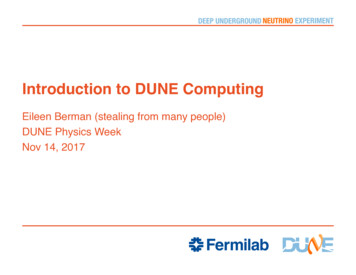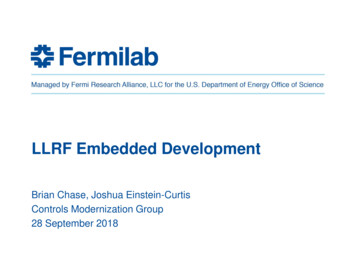![Introduction To SEIR Models - Indico [Home]](/img/37/0.jpg)
Transcription
Department of Epidemiology and Public HealthHealth Systems Research andDynamical Modelling UnitIntroduction to SEIR ModelsNakul ChitnisWorkshop on Mathematical Models of Climate Variability,Environmental Change and Infectious DiseasesTrieste, Italy8 May 2017
OutlineSI ModelSIS ModelThe Basic Reproductive Number (R0 )SIR ModelSEIR Model2017-05-082
Mathematical Models of Infectious DiseasesPopulation-based modelsIICan be deterministic or stochasticContinuous time IOrdinary differential equationsPartial differential equationsDelay differential equationsIntegro-differential equationsDiscrete time Difference equationsAgent-based/individual-based modelsII2017-05-08Usually stochasticUsually discrete time3
Mathematical Models of Infectious DiseasesPopulation-based modelsIICan be deterministic or stochasticContinuous time IOrdinary differential equationsPartial differential equationsDelay differential equationsIntegro-differential equationsDiscrete time Difference equationsAgent-based/individual-based modelsII2017-05-08Usually stochasticUsually discrete time3
OutlineSI ModelSIS ModelThe Basic Reproductive Number (R0 )SIR ModelSEIR Model2017-05-084
SI ModelSusceptible-Infectious Model: applicable to HIV.rβI/NSIdSI rβSdtNIdI rβSdtNS:I:r:β:N:2017-05-08Susceptible humansInfectious humansNumber of contacts per unit timeProbability of disease transmission per contactTotal population size: N S I.5
Analyzing the SI ModelThe system can be reduced to one dimension,dII rβ(N I) ,dtNwith solution,I(t) for I(0) I0 .Equilibrium Points:I0 N,(N I0 )e rβt I0Idfe 0Iee N2017-05-086
Analyzing the SI ModelThe system can be reduced to one dimension,dII rβ(N I) ,dtNwith solution,I(t) for I(0) I0 .Equilibrium Points:I0 N,(N I0 )e rβt I0Idfe 0Iee N2017-05-086
Numerical Solution of SI ModelInfectious Humans100080060040020000101520Time (Years)With r 365/3 years 1 , β 0.005, N 1000, and I(0) 1.2017-05-0857
Definition of Transmission ParametersNote that in some models, usually of diseases where contactsare not well defined, rβ (the number of contacts per unit timemultiplied by the probability of disease transmission percontact) are combined into one parameter (often also called β— the number of adequate contacts per unit time).For diseases where a contact is well defined (such as sexuallytransmitted diseases like HIV or vector-borne diseases likemalaria), it is usually more appropriate to separate the contactrate, r, and the probability of transmission per contact, β.For diseases where contacts are not well defined (such asair-borne diseases like influenza) it is usually more appropriateto combine the two into one parameter.2017-05-088
OutlineSI ModelSIS ModelThe Basic Reproductive Number (R0 )SIR ModelSEIR Model2017-05-089
SIS ModelSusceptible-Infectious-Susceptible Model: applicable to thecommon cold.γrβI/NSIdSI rβS γIdtNdII rβS γIdtNγ:Per-capita recovery rate2017-05-0810
Analyzing the SIS ModelThe system can be reduced to one dimension,dII rβ(N I) γI,dtNwith solution,I(t) 1 Nrβ · (rβ γ) ,N (rβ γ) (rβ γ)t 1erβI0for I(0) I0 .Equilibrium Points:Idfe 0(rβ γ)NIee rβ2017-05-0811
Analyzing the SIS ModelThe system can be reduced to one dimension,dII rβ(N I) γI,dtNwith solution,I(t) 1 Nrβ · (rβ γ) ,N (rβ γ) (rβ γ)t 1erβI0for I(0) I0 .Equilibrium Points:Idfe 0(rβ γ)NIee rβ2017-05-0811
Numerical Solution of SIS ModelInfectious Humans10008006004002000020304050Time (Days)With rβ 0.5 days 1 , γ 0.1 days 1 , N 1000, and I(0) 1.2017-05-081012
OutlineSI ModelSIS ModelThe Basic Reproductive Number (R0 )SIR ModelSEIR Model2017-05-0813
of uncertainty that may be prioritized for urgent resThe Basic Reproductive Number (R0 )Generation012Initial phase of epidemic (R0 3)Disease is endePan-InfORM (2009)2017-05-0814
Definition of R0The basic reproductive number, R0 , is the number ofsecondary infections that one infected person would producein a fully susceptible population through the entire duration ofthe infectious period.R0 provides a threshold condition for the stability of thedisease-free equilibrium point (for most models):IIIThe disease-free equilibrium point is locally asymptoticallystable when R0 1: the disease dies out.The disease-free equilibrium point is unstable when R0 1:the disease establishes itself in the population or an epidemicoccurs.For a given model, R0 is fixed over all time.This definition is only valid for simple homogeneousautonomous models.Can define similar threshold conditions for more complicatedmodels that include heterogeneity and/or seasonality but thebasic definition no longer holds.2017-05-0815
Definition of R0The basic reproductive number, R0 , is the number ofsecondary infections that one infected person would producein a fully susceptible population through the entire duration ofthe infectious period.R0 provides a threshold condition for the stability of thedisease-free equilibrium point (for most models):IIIThe disease-free equilibrium point is locally asymptoticallystable when R0 1: the disease dies out.The disease-free equilibrium point is unstable when R0 1:the disease establishes itself in the population or an epidemicoccurs.For a given model, R0 is fixed over all time.This definition is only valid for simple homogeneousautonomous models.Can define similar threshold conditions for more complicatedmodels that include heterogeneity and/or seasonality but thebasic definition no longer holds.2017-05-0815
Definition of R0The basic reproductive number, R0 , is the number ofsecondary infections that one infected person would producein a fully susceptible population through the entire duration ofthe infectious period.R0 provides a threshold condition for the stability of thedisease-free equilibrium point (for most models):IIIThe disease-free equilibrium point is locally asymptoticallystable when R0 1: the disease dies out.The disease-free equilibrium point is unstable when R0 1:the disease establishes itself in the population or an epidemicoccurs.For a given model, R0 is fixed over all time.This definition is only valid for simple homogeneousautonomous models.Can define similar threshold conditions for more complicatedmodels that include heterogeneity and/or seasonality but thebasic definition no longer holds.2017-05-0815
Definition of R0The basic reproductive number, R0 , is the number ofsecondary infections that one infected person would producein a fully susceptible population through the entire duration ofthe infectious period.R0 provides a threshold condition for the stability of thedisease-free equilibrium point (for most models):IIIThe disease-free equilibrium point is locally asymptoticallystable when R0 1: the disease dies out.The disease-free equilibrium point is unstable when R0 1:the disease establishes itself in the population or an epidemicoccurs.For a given model, R0 is fixed over all time.This definition is only valid for simple homogeneousautonomous models.Can define similar threshold conditions for more complicatedmodels that include heterogeneity and/or seasonality but thebasic definition no longer holds.2017-05-0815
Evaluating R0R0 can be expressed as a product of three quantities: Number ofProbability of DurationofR0 contacts transmission infectionper unit timeper contactFor SIS model:R0 r β 2017-05-081γ16
Reproductive NumbersThe (effective) reproductive number, Re , is the number ofsecondary infections that one infected person would producethrough the entire duration of the infectious period.Typically, but not always, Re is the product of R0 and theproportion of the population that is susceptible.Re describes whether the infectious population increases ornot. It increases when Re 1; decreases when Re 1 and isconstant when Re 1. When Re 1, the disease is atequilibrium.Re can change over time.The control reproductive number, Rc , is the number ofsecondary infections that one infected person would producethrough the entire duration of the infectious period, in thepresence of control interventions.2017-05-0817
Reproductive NumbersThe (effective) reproductive number, Re , is the number ofsecondary infections that one infected person would producethrough the entire duration of the infectious period.Typically, but not always, Re is the product of R0 and theproportion of the population that is susceptible.Re describes whether the infectious population increases ornot. It increases when Re 1; decreases when Re 1 and isconstant when Re 1. When Re 1, the disease is atequilibrium.Re can change over time.The control reproductive number, Rc , is the number ofsecondary infections that one infected person would producethrough the entire duration of the infectious period, in thepresence of control interventions.2017-05-0817
Reproductive NumbersThe (effective) reproductive number, Re , is the number ofsecondary infections that one infected person would producethrough the entire duration of the infectious period.Typically, but not always, Re is the product of R0 and theproportion of the population that is susceptible.Re describes whether the infectious population increases ornot. It increases when Re 1; decreases when Re 1 and isconstant when Re 1. When Re 1, the disease is atequilibrium.Re can change over time.The control reproductive number, Rc , is the number ofsecondary infections that one infected person would producethrough the entire duration of the infectious period, in thepresence of control interventions.2017-05-0817
Reproductive NumbersThe (effective) reproductive number, Re , is the number ofsecondary infections that one infected person would producethrough the entire duration of the infectious period.Typically, but not always, Re is the product of R0 and theproportion of the population that is susceptible.Re describes whether the infectious population increases ornot. It increases when Re 1; decreases when Re 1 and isconstant when Re 1. When Re 1, the disease is atequilibrium.Re can change over time.The control reproductive number, Rc , is the number ofsecondary infections that one infected person would producethrough the entire duration of the infectious period, in thepresence of control interventions.2017-05-0817
Reproductive NumbersThe (effective) reproductive number, Re , is the number ofsecondary infections that one infected person would producethrough the entire duration of the infectious period.Typically, but not always, Re is the product of R0 and theproportion of the population that is susceptible.Re describes whether the infectious population increases ornot. It increases when Re 1; decreases when Re 1 and isconstant when Re 1. When Re 1, the disease is atequilibrium.Re can change over time.The control reproductive number, Rc , is the number ofsecondary infections that one infected person would producethrough the entire duration of the infectious period, in thepresence of control interventions.2017-05-0817
Evaluating Re Number ofProbability of Duration of contactstransmissionRe (t) infectionper unit timeper contact Proportion of susceptible populationFor SIS model:S(t)N (t)rβS(t) .γN (t)Re (t) R0 2017-05-0818
The Basic Reproductive Number (R0 9
OutlineSI ModelSIS ModelThe Basic Reproductive Number (R0 )SIR ModelSEIR Model2017-05-0820
SIR ModelSusceptible-Infectious-Recovered Model: applicable to measles,mumps, rubella.SrβI/NIγRdSI rβSdtNdII rβS γIdtNdR γIdtR: Recovered humanswith N S I R.2017-05-0821
Analyzing the SIR ModelCan reduce to two dimensions by ignoring the equation for Rand using R N S I.Can no longer analytically solve these equations.Infinite number of equilibrium points with I 0.Perform phase portrait analysis.Estimate final epidemic size.2017-05-0822
R0 for the SIR Model Number ofProbability of Duration of contactstransmissionR0 infectionper unit timeper contactR0 r β 1γrβγIf R0 1, introduced cases do not lead to an epidemic (thenumber of infectious individuals decreases towards 0).If R0 1, introduced cases can lead to an epidemic(temporary increase in the number of infectious individuals).Re (t) 2017-05-08rβ S(t)γ N23
THE MATHEMATICS OF INFECTIOUS DISEASESPhase Portrait of SIR Model6051σ 3infective fraction, i0.80.60.40.2000.2 0.6susceptible fraction, s1 0.4smax σ0.81Hethcote (2000)2017-05-08Fig. 2 Phase plane portrait for the classic SIR epidemic model with contact number σ 3.24
Numerical Solution of SIR 040020000406080Time (Days)With rβ 0.3 days 1 , γ 0.1 days 1 , N 1000, andS(0) 999, I(0) 1 and R(0) 0.2017-05-082010025
Numerical Solution of SIR 040020000406080Time (Days)With rβ 0.3 days 1 , γ 0.1 days 1 , N 1000, andS(0) 580, I(0) 20 and R(0) 400.2017-05-082010026
Human DemographyNeed to include human demographics for diseases where thetime frame of the disease dynamics is comparable to that ofhuman demographics.There are many different ways of modeling humandemographicsIIII2017-05-08Constant immigration rateConstant per-capita birth and death ratesDensity-dependent death rateDisease-induced death rate.27
Endemic SIR DeathDeathdSdtdIdtdRdtNI µSN Λ rβS rβSI γI µIN γI µR S I RConstant recruitment ratePer-capita removal rate28
Analyzing the Endemic SIR ModelCan no longer reduce the dimension or solve analytically.There are two equilibrium points: disease-free and endemicSdfe ΛµΛ(γ µ)rβµΛ(rβ (γ µ)) rβ(γ µ)γΛ(rβ (γ µ)) rβµ(γ µ)See Idfe 0IeeRdfe 0ReeCan perform stability analysis of these equilibrium points anddraw phase portraits.2017-05-0829
R0 for the Endemic SIR Model Number ofProbability of DurationofR0 contacts transmission infectionper unit timeper contactR0 r β 1γ µrβγ µIf R0 1, the disease-free equilibrium point is globallyasymptotically stable and there is no endemic equilibriumpoint (the disease dies out).If R0 1, the disease-free equilibrium point is unstable and aglobally asymptotically stable endemic equilibrium point exists.2017-05-0830
Numerical Solution of Endemic SIR 040020000204060Time (Days)80100With rβ 0.3 days 1 , γ 0.1 days 1 , µ 1/60 years 1 ,Λ 1000/60 years 1 , and S(0) 999, I(0) 1 and R(0) 0.2017-05-0831
Numerical Solution of Endemic SIR 04002000020406080Time (Years)100120With rβ 0.3 days 1 , γ 0.1 days 1 , µ 1/60 years 1 ,Λ 1000/60 years 1 , and S(0) 999, I(0) 1 and R(0) 0.2017-05-0832
OutlineSI ModelSIS ModelThe Basic Reproductive Number (R0 )SIR ModelSEIR Model2017-05-0833
SEIR ModelSusceptible-Exposed-Infectious-Recovered Model: applicable tomeasles, mumps, µDeathDeathDeathDeathExposed (latent) humansPer-capita rate of progression to infectious state34
SEIR ModeldSdtdEdtdIdtdRdt Λ rβS rβSI µSNI εEN εE γI µI γI µRwithN S E I R.2017-05-0835
R0 for the Endemic SEIR Model Number ofProbability of Duration of contactstransmissionR0 infectionper unit timeper contact Probabililty of surviving exposed stage1ε γ µ ε µrβε (γ µ)(ε µ)R0 r β If R0 1, the disease-free equilibrium point is globallyasymptotically stable and there is no endemic equilibriumpoint (the disease dies out).If R0 1, the disease-free equilibrium point is unstable and aglobally asymptotically stable endemic equilibrium point exists.2017-05-0836
Extensions to Compartmental ModelsBasic compartmental models assume a homogeneouspopulation.Divide the population into different groups based on infectionstatus:M : Humans with maternal immunityS: Susceptible humansE: Exposed (infected but not yet infectious) humansI: Infectious humansR: Recovered humans.Can include time-dependent parameters to include the effectsof seasonality.Can include additional compartments to model vaccinated andasymptomatic individuals, and different stages of diseaseprogression.Can include multiple groups to model heterogeneity, age,spatial structure or host species.2017-05-0837
ReferencesO. Diekmann, H. Heesterbeek, and T. Britton, Mathematical Tools forUnderstanding Infectious Disease Dynamics.Princeton Series in Theoretical and Computational Biology. Princeton UniversityPress, Princeton, (2013).H. W. Hethcote, “The mathematics of infectious diseases”, SIAM Review 42,599–653 (2000).M. J. Keeling and P. Rohani, Modeling Infectious Diseases in Humans andAnimals.Princeton University Press, Princeton, (2007).2017-05-0838
Mathematical Models of Infectious Diseases Population-based models I Can bedeterministicor stochastic I Continuous time Ordinary di erential equations Partial di erential equations Delay di erential equations










